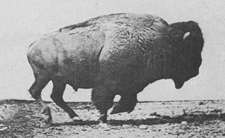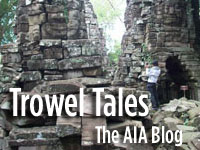Fear and Death on the Plains
by Heather Pringle
April 3, 2009
 In the interests of full disclosure, I should probably admit right up front that I have long taken a serious interest in bison and bison jumps. I was born and raised in Alberta, just north of the Great Plains, and one of the best summer jobs I ever had as a student was working at Elk Island National Park, where the Canadian government protected two good-sized bison herds. Early each morning, I used to drive into the park in a dusty old Ford truck my dad gave me, and most days I would find one of the herds straddling the road. I’d wait and watch,  and after a minute or two, some of the animals would deign to take notice, then part to let me pass. And even now, many years later, I still remember the feeling of awe I had as I gradually inched the truck in among them, surrounded by a dark brown sea of muscle, horn and fur.Â
In the interests of full disclosure, I should probably admit right up front that I have long taken a serious interest in bison and bison jumps. I was born and raised in Alberta, just north of the Great Plains, and one of the best summer jobs I ever had as a student was working at Elk Island National Park, where the Canadian government protected two good-sized bison herds. Early each morning, I used to drive into the park in a dusty old Ford truck my dad gave me, and most days I would find one of the herds straddling the road. I’d wait and watch,  and after a minute or two, some of the animals would deign to take notice, then part to let me pass. And even now, many years later, I still remember the feeling of awe I had as I gradually inched the truck in among them, surrounded by a dark brown sea of muscle, horn and fur.Â
               I noticed in the news this week a story about Head-Smashed-In Buffalo Jump, which is a UNESCO World Heritage Site in southern Alberta. The interpretive center there is celebrating its 22nd anniversary, but what caught my eye was a wonderful quote from Jack Brink, the archaeology curator at the Royal Alberta Museum. Brink spent 15 years working at Head-Smashed-In, excavating part of the massive 5500-year-old bone bed and analyzing the remains. In one drive alone, he once estimated, prehistoric hunters killed more than 225 bison, racking up some 100,000 pounds of meat. “This is the single greatest food-getting event ever devised by human beings,†noted Brink.  “Nobody ever produced more food in a single moment than people driving bison over a cliff.â€
               I know Jack Brink, and I once had the great pleasure of spending several days with him wandering around the massive site of Head-Smashed-In, with its 40-square-kilometer gathering basin and its more than 30 intersecting drive lanes made up of as many as 20,000 stone cairns.  One of the things that really impressed me, however, was how prehistoric hunters had pulled off such massive kills without being mounted on horseback. Â
               It turns out that they used every trick in the book—disguises, skilful acting, optical illusions and blinding light. The runners who lured the herd towards the jump, for example, dressed in animal hides to resemble antelopes or bison calves, and they impersonated these animals with uncanny skill. “Had I not been in on the secret,†noted one European observer lucky enough to witness a traditional hunt, “I should have been as much deceived as the [bison].† Â
  As the runners led the animals deeper into the drive lanes, hunters formed a human picket fence along the edges.  They waved their arms and whatever else they had, and frightened the animals into a stampede toward the edge. The drive lanes angled slightly downward, increasing the momentum of the top-heavy animals. But it was an optical illusion at the jump itself that really sealed the herd’s doom. Unbroken prairie ran right up to the bottom of the cliff: from the top, it looked as if a continuous grassy carpet spread to the eastern horizon. And if the runners managed to time things just right, the rising sun would have momentarily blinded the animals before they tumbled over the edge.
               Head-Smashed-In was a natural abattoir. But what strikes me most about it  is the incredible courage of the hunters.  It must have been terrifying for those positioned at the end of the drive lanes, waiting for all those thundering hooves to pass and hoping that none suddenly veered their way.Â
As much as I looked forward every morning to seeing that bison herd at Elk Island National Park, I always knew who the real masters there were. And as I nudged my truck towards them, I felt something very old indeed: a twinge of fear.     Â
Â
Readers interested in learning more about Head-Smashed-In might want to check out Jack Brinks’ new book, Imagining Head-Smashed-In.           Â
Comments posted here do not represent the views or policies of the Archaeological Institute of America.






 Heather Pringle is a freelance science journalist who has been writing about archaeology for more than 20 years. She is the author of Master Plan: Himmler's Scholars and the Holocaust and The Mummy Congress: Science, Obsession, and the Everlasting Dead. For more about Heather, see our
Heather Pringle is a freelance science journalist who has been writing about archaeology for more than 20 years. She is the author of Master Plan: Himmler's Scholars and the Holocaust and The Mummy Congress: Science, Obsession, and the Everlasting Dead. For more about Heather, see our 



